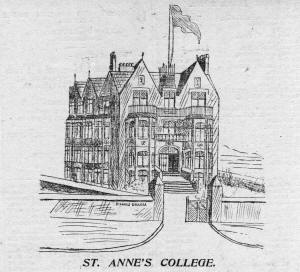Newspaper article from 1901
EDUCATIONAL
DEVELOPMENTS AT ST. ANNES.
A NEW COLLEGE
FOR BOYS.
St. Anne's
continues to keep pace with the growth of the town in providing facilities for
the education of the young, the latest addition being the college for boys
opened by the Rev. W. H. Johnson.
The
situation is an ideal one. Facing the sea the college stands only about fifty
yards from the water's edge, and as the lads are at study in their large
schoolroom, a glance through the window gives them a pretty view of the open
sea, the broad mouth of the Ribble, with the incoming and outgoing steamers and
busy fleets of fishing smacks. Across the water, on a clear day, Snowdon stands
out clearly defined, as well as many miles of coast line, Southport, in the
clearest atmospheres, appearing to be but two or three miles across. From the
boys' bedrooms on the third and fourth storeys is obtained a picture that cannot
fail to be as stimulating as the ozone-laden air coming fresh from the
sea.
The lads are
exceedingly fortunate in having such a healthy situation. But undoubtedly one of
the best views it is possible to imagine is obtained from a platform erected on
the top of the building. To the west of the college the coast line is clearly
traced, the turrets and gigantic tower of Blackpool, together with the big wheel
standing out prominently, whilst to the east Fairhaven and Lytham, the former
with its new church and beautiful lake in the foreground, whilst Lytham's Pier,
long stretch of Promenade, and glorious trees make a picture that one never
tires of admiring. When the brain gets weary of study nothing is calculated to
restore it so well as such an entrancing view.
Unfortunately there was no vacant land adjacent to the college suitable for a
recreation ground, and a field has been secured behind St. Thomas's Church,
where the lads indulge in cricket and football, and the physical development of
the students has been entrusted to Sergeant-Instructor Howard, instructor to the
Lytham Volunteers. At meal times the lads retire to a large comfortable
dining-room on the basement, and when all other recreation is precluded by
stress of weather, the spare moments of the boys are spent here in chess,
draughts, dominoes, etc. It is therefore not surprising to learn that the number
of pupils is increasing every term.
The
principal (Rev. W. H. Johnson) took over the school about four years ago, and it
was then conducted at Central Beach, Lytham. During the short period Mr. Johnson
has had control of the school his efforts have been attended by a remarkable run
of successes, and at the Oxford examinations last year out of the thirteen
successes from the Fylde district, five were pupils of Mr. Johnson. It is a
striking testimony to the personal zeal which the principal takes in his
pupils.

The new
college stands back about thirty yards from the South Promenade. There are four
entrances, the main entrance facing the sea, the basement entrance, and two
entrances being at the back of the college. The school is reached by a slope,
and stands about five feet above the level of the road, so that there is no
obstruction to the sea view. The rooms to the left constitute the schoolrooms
(one large and two small) and a class room, the one to the front being a large
and spacious room, 33 feet long by 18 feet wide, with a height of 12 feet. It
contains two fire places and two large windows, the ventilation being most
satisfactory.
The principal's drawing-room
and dining-room are to the right on the main floor, and at the rear a laboratory
has been fitted up. The entrance hall is 9ft, wide and 26 yards long, the walls
being green tinted, the windows are of coloured glass, the latter being a
feature throughout the building. The floor is tiled and carpeted. The students'
dining-room 1.s on the basement floor, is about 60 feet long, and connected with
three large kitchens, the basement also containing boys' coat and cloak-room,
boot room, and pantries, wits masters' study at the front.
On the ground floor and the two
upper storeys are lavatories with bath-rooms on the third and fourth storeys,
where the boys’ dormitories are located. There are thirteen of these, all light
and airy, and fitted with every convenience, in addition to seven bedrooms for
private use. All the rooms are lofty, giving more than ample air space, and
throughout the place it is apparent that the body as well as the mind is given
every possible advantage. The lads are trained for either a commercial or
professional career, or for entrance to the Universities.
|